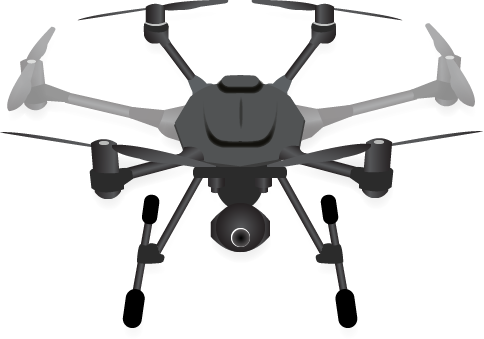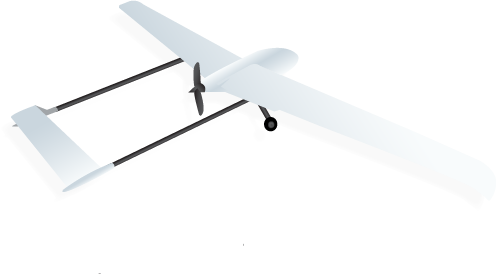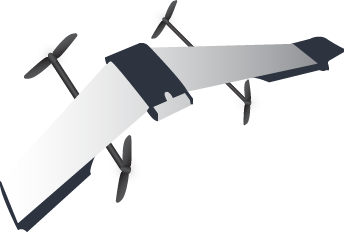How are drones used for inspections? What can drones inspect? And how do you start a drone inspection business? This article will answer those questions and a few more, to get you well off the ground.
How are drones used for inspections? What can drones inspect? And how do you start a drone inspection business? This article will answer those questions and a few more, to get you well off the ground.
Drones are used for inspections the same way any camera is used; to document the physical conditions on an inspection site. Simply put; drones are cameras with wings, that let the inspector take pictures of anything he/she finds relevant while performing the inspection.
The ability to fly, gives drones a major advantage over handheld cameras, as they can go further, faster, and more safely. This is the main reason that most inspections of infrastructure are using drones in 2022. Smaller drones that can be used for inspections in tight spaces like chimneys or inside pipes are also a growing market. The advantages are much the same as “traditional” rotor drones.
The drone inspection and monitoring market size reached $9,80 billion in 2021 and rapid growth in the coming years is expected.
An overview of the areas that use drone inspections the most:
Drone inspections are extremely versatile, not only in terms of inspection area but also inspection method.
Firstly, drones can capture data from angles that show the subject in detail, or provide a great overview of an area or site. The fact that there are so many different UAVs (unmanned aerial vehicles) of varying sizes and with different functionalities, means there are options for almost any inspection type; from indoor, tight space to long-stretch railway surveying. Almost any subject can be inspected using a drone, and you will get the best quality data – provided that you use the right payload, of course.
Secondly, let’s dive into payloads (what is attached to the drone). What is needed, depends on what is inspected. Some issues are not visible or regular rgb images and require special cameras, to be seen clearly.
Thermal cameras
Any inspection where you need to look at differences in heat can benefit from using s thermal camera. The images quickly uncover are leakage or significant difference in temperature, in the inspected subject. These are often used for building inspections or inspections of Solar PV.

LiDAR
Light Detection and Ranging cameras are useful when an exact representation of physical conditions are needed in a digital form. LiDAR cameras capture a distance from the camera to a given object, creating what is called a point-cloud. In digital form, it provides a millimeter-correct image of the surveyed area, and allows for exact measurements. It is commonly used for identifying encroaching trees on power lines, or mapping larger areas.

Corona imaging
Corona is electricity escaping high-voltage power lines, and corona sensors are able to capture these eruptions on video.

Once data is captured, there is the matter of post-processing. It’s most commonly used to create a ¨complete” image of an asset, based on pieces of data. Besides LiDAR, photogrammetry is often used to generate digital twins, 3D models, or orthomosaics on inspected assets or areas. It is not as millimeter-accurate as LiDAR, but depending on the post-processing method, it can be very accurate and also include differences in terrain. It is widely used in all inspection types.
In short, drones can inspect anything that a camera can inspect, from a multitude of heights and angles.
There are three main types of drones used for inspections: multi-rotor, fixed-wing, and hybrid models.
Multi-rotor
Multi-rotor drones have more than one rotor, allowing them to take off and land vertically (as opposed to traditional aircraft). They are also able to maneuver easily and change direction quickly, as motors can operate individually. This makes them ideal for a range of inspection tasks. Most multi-rotor drones are also able to carry multiple payloads, meaning a single flight can provide a lot of information. Their disadvantage is the inefficiency of battery-powered rotors, which causes short flight times between charges and a slower pace while flying. Despite the inefficiency, they are the most popular choice for inspections of infrastructure.

Fixed-wing
Fixed-wing drones are similar to planes in the sense, that has a single wing which they use to stay airborne. They excel where multi-rotor drones fail; in speed and energy efficiency. They can fly vast distances, fast, and because of this, they are often used when capturing for photogrammetry or mapping. They are harder to fly and steer than their multi-rotor counterparts and require more equipment for takeoff and landing too.

Hybrid (fixed-wing VTOL)
Hybrid drones are a merge of fixed-wing and multi-rotor drones, offering the advantages from fixed-wing drones along with vertical takeoff and landing, as well as hovering. This is a relatively new market and only a handful of drones of this type are currently available and they are not usually used in inspections.

The best drone for inspection work will always depend on the work and your wallet. There are a ton of inexpensive little drones out there, that performs incredibly well. There are also more expensive alternatives, which are amazing too.
If you want to know more about choosing the right drone, I have written about that in more detail here.
We’ve cross-referenced the 5 articles, to find the models most often mentioned as “best drone for inspections”, and found the following:
DJI Mavic 2 Enterprise Advanced
DJI Matrice 300 RTK
DJI Aspire 2
Parrot Anafi Work
“Drone service provider” is a title, that has come to life and blossomed in recent years. If you want to add this title to your email signature, there are a few things to consider. This article gives you an overview of those considerations – for more in-depth writing on the topic, visit our article here.
In any market, especially one as broad and with as large potential as this, you will need to find your niche. This includes considering your speciality, your customers, marketing channels and competitors and creating a business model. Considering these things, will ensure you stay focused, and make the right choices while starting, and growing your drone inspection business.
It’s important to consider what equipment is needed to run your operation. This goes beyond picking a drone, though that is a big part of it. Once you’ve matched your needs and budget, you can go invest and move on to professionalizing your operation.
Choosing Drone Service Provider as your business means you will have to comply with certain standards. You will need to consider Standardization Policy, Safety Policy, Training Policies, and Standard Operating Checklists.
Lastly, getting your software(s) in a row will ensure not only quality in your deliverables, but also that everything you do, is documented from the beginning. This will add exponential value down the road. The right software is often what distinguishes a successful drone inspection business from a closed one. The software you will need includes flight planning software, data management software, and possibly more, depending on your model.
You can read the full, detailed article here.
If you are the one inspecting assets in your business, there are a few extra things to consider, before you can get started. The most important one is getting certified. “Drone inspectors” need certification – which one(s) depends on the country you operate in. If you work in the united states, for example, these are the rules.
There are best practices for how to capture data, to make the post-processing more effective. If you’re using Scopito, we have a library of Capture Guides online.
Unfortunately, there is no one answer for this popular question. What we can offer is a guide for pricing your services based on your costs, offering and desired markup. You can read the detailed description here – the below is a summary.
When deciding on your pricing, you need to consider:
I.e. insurances, travel expenses, equipment and software.
The size of the markup should be determined by the time you spend on the job, the general price-level and budget of your client.
You can read the full, detailed article here.
If you’re considering adding drones inspections to your operation, we have a great article for you, based on experiences from our customers who have established their drone operations. You can read it here – this article only includes a summary of the headlines.
As a rule of thumb, start your drone operations with a small project. You can use this project to prove the effectiveness on a larger scale. You will need a few essentials like a drone, a pilot and the necessary software.
Once your proof of concept is finished, you should present the findings to the relevant people. Granted that the ROI looks good, and you get a go ahead, you can move on to step three.
This is a crucial step. When ramping up to a large drone inspection operation, you need to consider you future needs ahead of time. This will allow you to document your findings in a way, that opens the door for predictive maintenance down the road.
Words of wisdom
– Keep visions big but take small manageable steps to get there.
– Choose a beachhead, prove the ROI and expand.
– Do it; start now.
– Even $5000/a month is enough.
– Crawl, walk, run methodology.
– Learn as you go.
This article was written by Scopito. We specilize in visual data management, and we can do a lot to help your project get off the ground. Contact us for a talk about getting started with your data handling the right way.
Trusted by





Enter your details below to continue
I have read the Terms of Use and declare that I agree
Please send me occasional e-mails about the product.
14 Days free trial starts automatically when you sign up